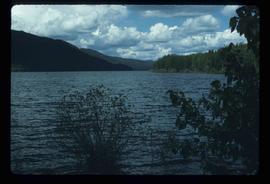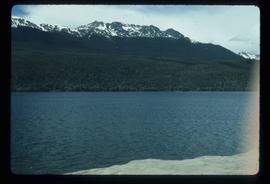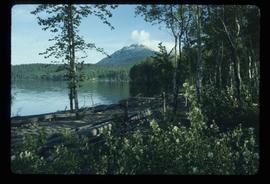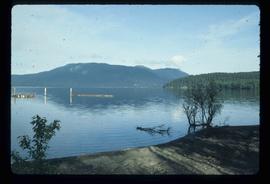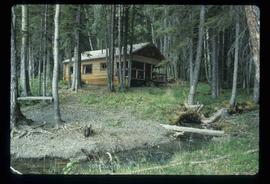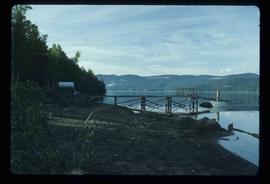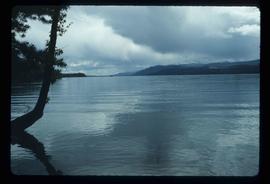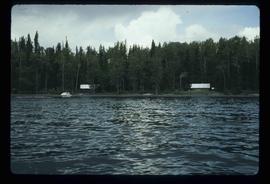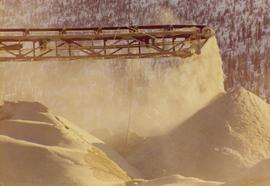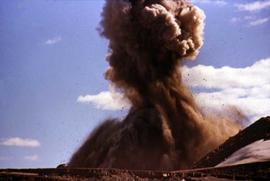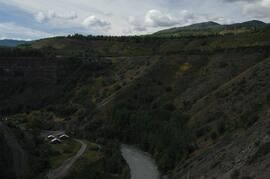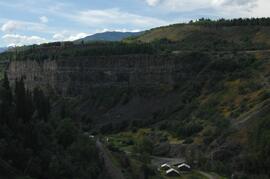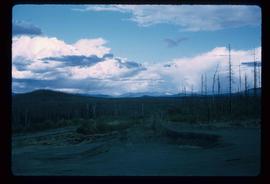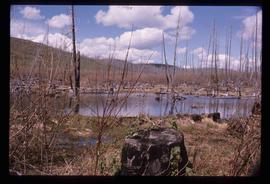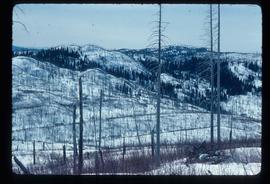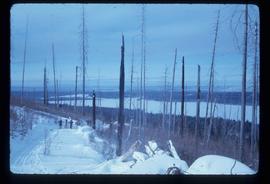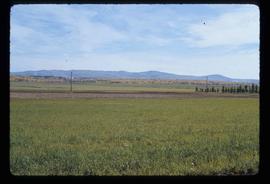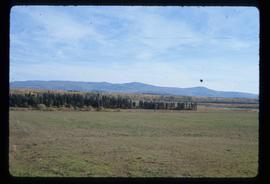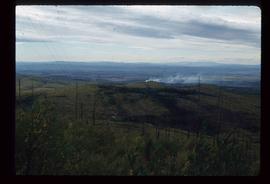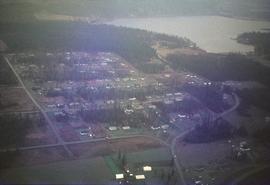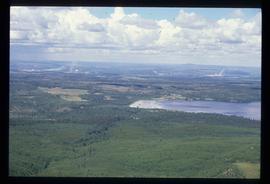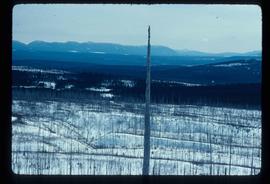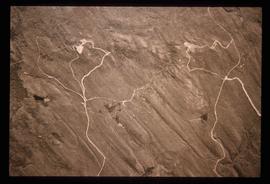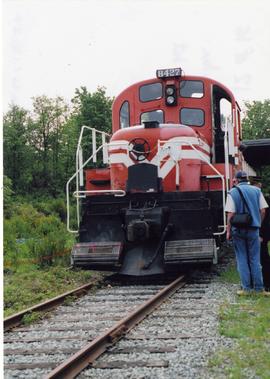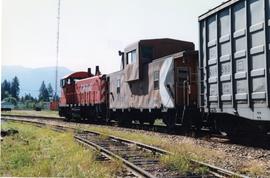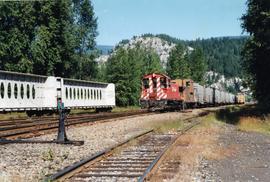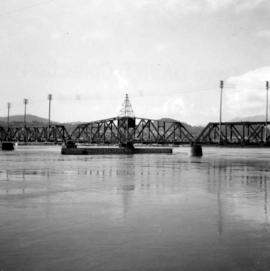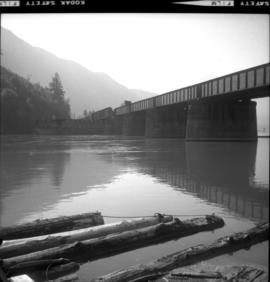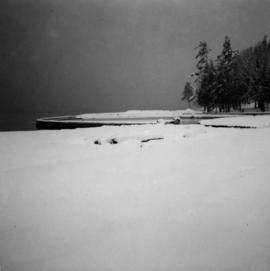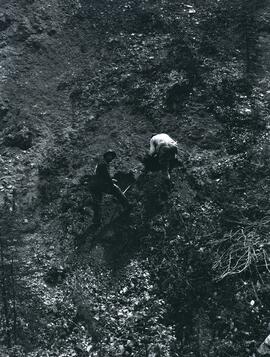Takla Lake, Northern British Columbia
Image depicts Takla Lake west of Leo Creek.
Image depicts Takla Lake west of Leo Creek.
Image depicts a lake with a mountain in the distance, viewed "west from lodge;" it is possibly Takla Lake.
Image depicts a lake, viewed "west from lodge;" it is possibly Takla Lake.
Image depicts a cabin on the "west arm" of Takla Lake.
Image depicts a lake viewed "south-east from lodge;" it is possibly Takla Lake.
Image depicts a view of Takla Lake from a cabin on the "west arm."
Image depicts two cabins on the shore near the lodge at Takla Lake.
Yoho National Park
"CaTo" on shore, Northern British Columbia
Photograph depicts the view from one of Jack Henderson-Roe's cabin windows. A treed hill is present in the background, and sparse trees form the foreground.
Autumnal foliage against a brilliant blue sky
Photograph depicts the Cassiar plantsite behind tailings pile in foreground. Mine road runs north though valley bellow mine, strip mining barely visible in background. Photograph was taken from above, facing north.
Photograph of outside of tailing bins at Nordenham Germany. Part of Trip Report.
Photograph of equipment in tailings pile.
Photograph depicts a tailing pile explosion at the Clinton Creek mine.
Item is a audio interview recorded by Bridget Moran with Jimmy, Rosie, Nancy, and Madeline.
Audiocassette Summary
00’ 05” Continuation of interview with Jimmy. Jimmy says his grandfather is French, not German, like Justa thinks. Moran and Jimmy continue to talk about the history of his grandparents. Jimmy continues to talk about his family history. They talk about the history of their last name, Monk.
12’ 08” Interview changes to Rosie. Moran asks Rosie about her siblings and other family history. Moran asks about the history of their last name, Monk. She believes her descendants are French. They continue to talk about her family history.
19: 22” Moran asks Rosie about the time Justa murdered John. Rosie talks about the situation candidly. She talks about John’s family life.
26’ 30” Moran asks Rosie about attending residential school. Rosie says school was alright for her, that they looked after them. She came home after six years.
28’ 30” Rosie talks about traveling around with her father because he worked many different jobs.
29’ 55” Rosie talks about getting married, how she got to choose her own partner, instead of having it arranged. She discusses her children.
32’ 05” Moran asks if Rosie had a good childhood. Rosie says yes, but her parents were strict. She remembers her father having to pay a land tax because they did not live on reserve land. She continues to talk about her childhood.
37’ 16” Rosie talks about life in residential school. Nancy says the nuns were kind; that they had to punish them if they spoke their native language.
38’ 50” Interview changes to Nancy. Moran asks about the history of their last name, Monk. They talk about her family history.
45’ 43” Moran asks Nancy about the time Justa killed his brother, John. Nancy talks about what she can remember.
47’ 32” Moran asks Nancy about the death of her brother, Teddy. She tells Moran the story she was told by the police.
49’ 34” Moran asks Nancy when she went to residential school. Nancy talks about having convulsions, so only spent two years there, then came home. When she was feeling better, she went back for another two years. She said her time there was not that bad, but she was homesick and lonely.
53’ 16” Moran asks Nancy if she had a good childhood. Nancy tells her she did, that they did everything for their parents.
56’ 07” Interview changes to Madeline. Moran asks about the history of their last name, Monk. Madeline does not know much about it. They continue to talk about the history of the family.
1:02’ 45” Madeline tells Moran about how she knocked Justa out with a block of ice because he was teasing her when they were children. Justa was a big tease, she says. Madeline says that Justa collected a box full of ‘treasure.’
1:09’ 10” Moran asks Madeline about her mother and how much she sewed for other people.
1: 10’ 44” Moran asks about when Madeline went to residential school. She tells Moran that she liked it there. Those who went there have discipline, she says.
1: 12’ 55” Madeline tells Moran that her parents were strict. She talks about being punished when breaking the rules, much like being at the residential school. They return to discussing residential school.
1: 17’ 55” Moran asks Madeline about what she remembers about the trips between Portage and Fort St. James. She talks about traveling by canoe once with her grandfather.
1: 20’ 33” Moran tells Madeline what she plans to write about in the book, particularly the first chapter dealing with the family history and life before the road being built to Portage.
1: 23’ 25” They return to talking about the family history, including aunts. They talk about her siblings.
1:30’ 07” Moran asks about Justa Hanson, the man Justa was named after. He was living in Tachie at the time Justa was born.
1:32’ 40” End of tape.
Item is a audio interview recorded by Bridget Moran with Justa Monk's family members.
Audiocassette Summary
00’ 05” Moran is talking to Justa’s sister, Adelle. She says the old way of life is better than life today. They talk about the lack of gardens in Tachie today.
02’ 45” Adelle talks about the family history, particularly her father. She talks about their way of life when they were children. Adelle continues to talk about her past.
08’ 40” Adelle talks about the residential school and how she was upset she was when she was sent there. She talks about being punished for speaking their native language. She was at the residential school until the age of sixteen.
12’ 13” Moran asks Adelle about what she remembers about fishing. She talks about the process of fishing.
13’ 22” Adelle talks about her individual history. She talks about not getting married at all because she could not marry the man she wanted. She talks about getting tuberculosis and being in the hospital for a year. When she was released from the hospital, she moved in with a man who was abusive towards her. She talks about leaving him and moving to Prince George, eventually.
18’ 56” Adelle talks about how it was beneficial that her parents were strict. She continues to talk about her childhood, particularly Christmas.
24’ 36” Moran and Adelle talk about when Justa killed his brother. Adelle tells Moran that Justa looked after his brother’s children after he was released from prison.
26’ 08” Moran asks Adelle about whether she drank or not. Adelle says when she moved to Prince George she began to drink heavily.
27’ 35” Moran asks Theresa about the time her and Justa got married. Adelle tells Moran that Justa was the baby of the family and how his siblings ‘babied’ him, hence why his mother was so upset when he married Theresa.
31’ 00” Interview changes to Theresa’s mother. Theresa’s mother speaks in her native language most of the time and Theresa translates. They talk about her past, particularly where and when she was born. They talk about how many families lived in Tachie.
40’ 13” Moran asks about whether Theresa’s mother went to Fort St. James often before the road was built. When they went to Fort St. James, by horse, they would buy some groceries.
43’ 04” They continue to talk about Theresa’s mother’s past.
47’ 33” Moran interviews Jimmy, Justa’s brother. She begins by asking him with the road being built. He tells her life was better in the old days because it was cheaper.
50’ 10” Moran asks about the family history. Jimmy lists the siblings from oldest to youngest.
52’ 05” Jimmy tells Moran that he did not go to the residential school because his grandfather would not let him. Jimmy needed to work for the family because he was the oldest. He talks about everything being done by hand.
58’ 00” Moran asks Jimmy about the type of house that his parents lived in when he was born. He talks about his childhood and his way of life. He talks about helping building a house with his father that had no rooms.
1: 02” 53” Moran asks Jimmy when he got married. Jimmy talks about his wife’s family, particularly his father-in-law, who Justa was named after.
1: 04’ 58” Moran asks Jimmy his memories about living in Portage. He tells her he was a bad kid. He also talks about the trips he took to the surrounding areas. He tells her it was a hard life, but there were good things.
1:10’ 35” Moran asks Jimmy about any memories he has of Justa as a kid. Jimmy tells her that even as a kid, Justa was pretty smart. Jimmy would take him to collect hay. Justa was called the baby and was spoiled too much.
1: 13’ 09” Moran asks Jimmy where he was when Justa got in trouble with his brother. Jimmy said he had a feeling something bad was going to happen, so decided to go home. He talks about when he was told about the murder. Moran continues to ask about the situation, but Jimmy tells her he is still not sure what happened between Justa and John.
1:25’ 03” Jimmy talks about making his store bigger at the pressure of Indian Affiars, but it was too much to keep operating, so now there is only a store that sells junk food.
1:28’ 47” Jimmy talks about the loss of two of his children. He continues to discuss his children.
1: 34’ 36” End of tape.
Image depicts a view of Tabor Mountain in Prince George, B.C.
<i>Epilobium</i> in flower across a grassy mountain slope
Image depicts a forest of dead trees on the slopes of Tabor Mountain in Prince George, B.C.
Image depicts a forest of dead trees on the slopes of Tabor Mountain in Prince George, B.C.
Image depicts a forest of dead trees on the slopes of Tabor Mountain in Prince George, B.C.
Image depicts a view of the area around Tabor Mountain in Prince George, B.C.
Image depicts Tabor Mountain in the distance, located in Prince George, B.C.
Image depicts a view of the area around Tabor Mountain in Prince George, B.C.
Image depicts Tabor Mountain from the airport in Prince George, B.C.
Image depicts a view of Prince George, from Gunn Point in the L.C. Gunn Park.
Image depicts the Tabor Lake Subdivision in Prince George, B.C.
Image depicts a view of Tabor Lake.
Image depicts grooving on Tabor Mountain in Prince George, B.C.
Image depicts grooves on Tabor Mountain in Prince George, B.C.
The item is a photograph depicting a wooden privy in a field where the site of the Sylvan Glade elementary school was located at Vivian Lake. Annotation on reverse side of photograph states, "Sylvan Glade school site #2, privy."
The item is a photograph depicting a wooden privy in a field where the site of the Sylvan Glade elementary school was located at Vivian Lake.
The item is a photograph depicting a field where the site where the Sylvan Glade elementary school was located at Vivian Lake. Annotation on reverse side of photograph states, "Sylvan Glade school site #1."
Photograph depicts a switching locomotive and stand-in locomotive.
Photograph depicts switcher #8106 and caboose #434612 that just arrived with a loaded train from a pulp mill. To the left lay the main track to Nelson.
Photograph depicts switcher #8106 that served the 3 mile branch to a pulp mill. The switcher pulled with heavy string of loaded cars from the mill. The trip was a caboose run. Locomotive built in 1958 as part of a batch of 31. 17 of them remained in 1997.
Photograph depicts the swing span of the road and rail bridge at Mission City, looking upstream from the south bank.
Photograph depicts the CPR swing bridge crossing the Harrison River at Harrison Mills. It is a plate girder bridge carrying a double track. The bridge tender occupied a shanty at the east end of the bridge at mile 68.3 from North Bend. The timetable states that trains may proceed at restricted speed after stopping, if the tender fails to appear after 4 whistle signals and the hone signals show stop.
Photograph depicts a swimming pool at Second Beach in Stanley Park, Vancouver, B.C. The snow in the foreground is 16 inches deep and there is a gathering snowstorm in the background coming in from the west.
Image depicts numerous unknown individuals swimming in a lake or standing on a dock at an uncertain location.
Photograph depicts Clarence Waldof, Henry Waldof, Ethel Waldof, and another woman swimming in Summit Lake.
Photograph depicts two men inspecting dirt at Swiggums' mining claim near Osilinka River.
Panorama, Prince George, British Columbia
